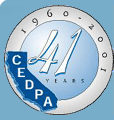

DataBus - Vol 40 No 2: February-March, 2000
|
Use It or Lose It
I'm worried about a subtle but dangerous occupational hazard. You and I sit in deep communion with our computer monitors for most of our waking hours; our minds may be engaged, but our faces look like out-takes from Night of the Living Dead, (Peek around the office right now. Johnson sits slack-jawed, locked in the tractor beam of his monitor. Williams slumps in her chair, her eyes half-open toward the flitting video images.) What's going on here? A vital component in our repertoire of professional skills is in danger of atrophy--the non-verbal side of our day-to-day communication isn't getting exercise. We're all becoming poster children for the Deadpan Society. So what? I'm not suggesting that we start smiling and gesturing at our computer monitors. But when we turn away from our CRTs for face-to-face meetings with clients or coworkers, we have increasing trouble jump-starting our non-verbal charms (such as eye contact, facial expressiveness, gestures, and posture). That's bad for business, bad for the team, and bad for individual careers. Virtually all research on human communication points to the predominant influence of nonverbal cues in interpersonal relations. When nonverbal cues are missing, communication itself breaks down in the workplace. (Results: bad meetings, boring interviews, unproductive contacts with clients, and crossed signals with the boss.) What you show is as important as what you say in getting your message across. Don't believe it? Put this idea to the test by recalling the last time you returned an article of clothing to a store (or, heaven help you, a software package you've opened). Was it the clerk's words, "Yes, we'll exchange it." Or the clerk's expression and tone of voice that communicated the real message and left a lasting impression? We "read" nonverbal signals very accurately. When the dictionary meanings of words conflict with the nonverbal signals that accompany them, we believe the messages sent by the nonverbal signals, not the words. There's a rueful irony here for specialists in fonts, graphics, and effects. Designers know better than most how important the "look" can be in making an impression and communicating the whole message. Yet they are as prone as anyone to ignore their own nonverbal signals--in effect, their facial graphic--when talking to others in the workplace. I can't prescribe what your face, eyes, and hands should be doing during non-virtual communication. But I can share my own short list of reminders when I turn from the monitor to meet with colleagues, students, and clients. Maintain comfortable eye contact. Shifty, nervous eyes send messages that undercut your words. Use your hands to emphasize ideas. "Handling" your words in meaningful ways helps others interpret your message. Show obvious interest with your face. Neutral expressions will be interpreted as signs of disapproval or lack of attention. Lean a bit forward to listen. The laid-back sprawl communicates a lack of concern and energy. Touch things you're talking about (within limits, of course). Holding a proposal, picking up the new software release, or touching your finger to numbers on a chart are all high-involvement communication techniques. The language of nonverbal cues and signals is a must-have for your processional success. And yes, I'm looking right at you and gesturing as I write this.
Arthur H. Bell, Ph.D., is a Professor of management Communication at the McLaren School of Business, University of San Francisco. He welcomes contact at [email protected].
This article originally appeared in the January/February, 2000, issue of Adobe Magazine. Copyright © 2001 Adobe Systems Incorporated. Reprinted with permission from the author and Adobe Magazine, Volume 11, No. 1, Jan/Feb 2000. |
CEDPA